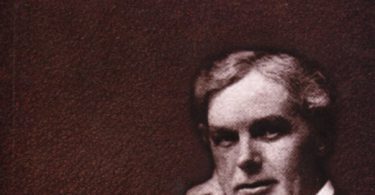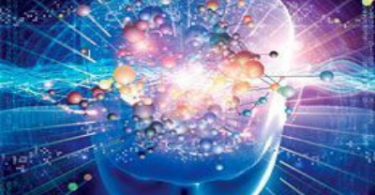
Introduction- Infertility is failure to conceive within one or more year of regular unprotected coitus. Usually 10-15% population remain infertile by the end of second year besides unprotected sex due to some causes in male or/and female. If we take into consideration the limitations and complication of the surgical procedure for treatment in allopathy, homoeopathy can provide an actual solution for such conditions. There are several ways of homoeopathic prescription such as based on key note symptoms, general symptoms, constitution, miasms, etc. Two cases of infertility- one of habitual abortion due to chromosomal abnormality in second month of pregnancy and another due to endometriosis and adenomyosis are presented here who were prescribed on constitutional symptoms and got good results.
Case profile– In the first case the symptoms were pain during periods with profuse flow and habitual abortion during second month of pregnancy. Chromosomal study gave complete Trisomy 12. In second case there were severe pain during periods. Repeated USG showed endometriosis and adenomyosis of uterus. Laparoscopic surgery and IVF failed to yield favourable treatment. After detailed case taking, basing on constitutional symptoms, Calcarea carbonicum 0/1-0/8 in first case and, Sepia officinalis 0/1-0/7 in second case provided good results with successful conception followed by delivery of a normal baby in each case.
Conclusion- Homoeopathy provided good results in two cases of infertility. Constitutional medicines were found useful in successful conception and subsequent continuation of pregnancy followed by delivery. As the totality of symptoms matched with the polychrest homoeopathic remedies like Calcarea carbonicum and Sepia officinalis, these remedies provided best results. But the inferences drawn from these two cases may not be sufficient to reach a definitive conclusion. So clinical trials to establish the efficacy of constitutional medicines in the treatment of infertility are suggested.
Keywords- infertility, endometriosis, habitual abortion, homoeopathy, constitutional medicine, Calcarea carbonicum, Sepia officinalis.
Abbreviations- USG – ultrasonography, IVF – in-vitro fertilisation, WHO – World Health Organisation, STDs – sexually transmitted diseases, STIs – sexually transmitted infections, HSG – hysterosalpingogram, FSH – follicle stimulating hormone, TSH – thyroid stimulating hormone, sos – si opus sit, bd – twice a day, glob. – globules.
INTRODUCTION
According to the International committee for monitoring assisted reproductive technology, World Health Organisation (WHO), infertility is a disease of reproductive system defined by failure to achieve the clinical pregnancy after 12 months or more of regular unprotected sexual intercourse. 1 It may be that one partner cannot contribute to conception, or that a woman is unable to carry a pregnancy to full term. It is often defined as not conceiving after 12 months of regular sexual intercourse without the use of birth control. 2
Worldwide, 8-12% couples experience fertility problems. As per the WHO estimates, 60–80 million couples worldwide currently suffer from infertility. It was reported that 40% of infertility cases were related to men, 40% of women and 20% of both sexes. 1 Many of the risk factors include age, tobacco use, alcohol use, being overweight, being under weight, lack of exercise etc.3
The number of infertility visit has increased in last few decades. The couples are voluntarily delaying child bearing for establishing careers which leads to age related infertility. Choice of prior contraceptive method may contribute to infertility. Increased number of sexual partners lead to greater potential for STDs which may also contribute to infertility.4
In the female reproductive system, infertility may be caused by: tubal disorders such as blocked fallopian tubes, which are in turn caused by untreated sexually transmitted infections (STIs) or complications of unsafe abortion, postpartum sepsis or abdominal/pelvic surgery; uterine disorders which could be inflammatory in nature (such as endometriosis), congenital in nature (such as septate uterus), or benign in nature (such as fibroids); disorders of the ovaries, such as polycystic ovarian syndrome and other follicular disorders; disorders of the endocrine system causing imbalances of reproductive hormones including hypothalamus and the pituitary glands.
Availability, access, and quality of interventions to address infertility remain a challenge in most countries. Moreover, lack of trained personnel, necessary equipment and infrastructure, high costs of treatment, medicines, are major barriers even for countries that are actively addressing the needs of people with infertility.5
Cause of endometriosis is due to changing social pattern like late marriage, limitation of family size, which is frequently associated with infertility. Clinical pictures of endometriosis are dysmenorrhea, dyspareunia, menorrhagia, and infertility. 6
Investigations like transvaginal ultrasound, laboratory testing of blood levels of certain hormones like oestradiol, FSH, TSH, and prolactin, hysterosalpingogram (HSG) for evaluating fallopian tubal patency, uterine filling defects such as fibroids and polyps, and scarring of the uterine cavity should be done to know the cause of infertility.
Conventional treatment are done like medications to induce egg development and ovulation, insemination, in vitro fertilisation (IVF), third party reproduction. Surgery can be done for removing scar tissue, endometriosis, or a damaged fallopian tube by laparoscopy, hysteroscopy for fibroids or polyps within the uterine cavity. 7
Some complications can result from infertility and its treatment. If conception does not occur after many months or years of trying, it can lead to stress and possibly depression. Some physical effects may also result from treatment. Ovarian hyper stimulation syndrome is one of the complication where the ovaries can swell, leak excess fluid into the body, and produce too many follicles, the small fluid sacs in which an egg develops. This usually results from taking medications to stimulate the ovaries, such as clomiphene and gonadotropins. It can also develop after IVF.8
The role of Homoeopathy in these conditions needs to be evaluated diligently. Homoeopathy is the system of therapeutics based on the law of similia, which states that a medicine capable of producing a disease state in a healthy person can cure a similar state in a diseased person, if it is in a curable state. 9Homoeopathic treatment has been found to be very efficacious and cost effective. 10There are many medicines mentioned in the homoeopathic materia medica whose symptoms match with those of symptoms of infertility patients.11A homoeopathic remedy can be selected on the basis of causation, specificity, keynote, miasm, organopathy, constitution or totality of symptoms, etc. 12 Constitution is the physical and mental makeup of the person, which is the combination of his/her physical built, cravings, aversions and reactions to different foods, drinks and environmental factors as well as emotional and intellectual attributes. So, a constitutional prescription is based on the totality of the characteristic mental and physical features.13 Though the physical generals can easily be elicited from the patient, accurate retrieval of mental symptoms needs skill, compassion and patience of the physicians.14
Several studies have already been established to show the efficacy of homoeopathy in treatment of infertility.15–17 There is a global need for carrying out evidence-based research, to avoid the unnecessary ill-effects of antibiotics, hormonal therapy and complicated surgeries and to highlight the effectiveness of Homoeopathy in the treatment of infertility.
In this context, two cases of Infertility are presented here in which well selected constitutional medicines had bring forth successful conception.
Case profiles
These two cases of infertility were treated in the OPD of Dr. A.C. Homoeopathic Medical College and Hospital, Bhubaneswar, Odisha.
Case 1
A woman aged 32-years presented with habitual abortion at 9-10 weeks of gestation. She had regular periods, profuse flow with clotted blood and pain in lower abdomen which extends to back and thigh. Pain in cervical region and pain in left breast aggravated during menses. She had also palpitation sometimes marked. The patient was moderately obese, Chilly and had tendency to catch cold easily with laziness. She desired for sweets and warm food, she was constipated and ineffectual urge for stool. Mentally she was fear full when alone, memory weak, and desired for company. On physical examination no abnormality is detected. On investigation of chromosomal study for habitual abortion Complete Trisomy 12 was detected. (Foetus in this defect will spontaneously abort and responsible for habitual abortion within first trimester). She had treated allopathically for the presenting complaint but failed (Table1). The case was repertorised with the help of complete repertory of HOMPATH (Classic) software (Fig. 2). Basing on the repertorial analysis and in consultation with materia medica, Calcarea carbonicum in 50 millesimal potency 0/1- 0/4, 30 ml each in 8 doses, once daily morning for 32 days, and Jonasia ashoka Q 30 ml, 15 drops twice daily were prescribed. After one month, pain in breast and pain in cervical region before menses diminished, abdominal pain during menses decreased, laziness absent, tremor and palpitation absent. Then Calcarea carbonicum 0/5 – 0/8 was given, 30ml, 8doses each in alternate morning. After two months she came having delayed period for 7days, nausea and weakness in morning with feverish feeling and pain in breast. Pregnancy test positive detected on that day. Calcarea carbonicum 0/9 30ml, 8doses twice a week, Sabina 30, 6glob once daily morning prescribed for another one month. Then in 11 weeks First trimester risk assessment test was done for trisomy 21, trisomy 13 and trisomy 18. All are under low risk and bellow the screening cut off. Ultrasound for pregnancy/foetal scan with doppler report (Fig. 3) shows single live Intrauterine foetus of gestational age 12wks 1day with no obvious congenital anomalies detected. And the mother delivered a normal baby after 9months pregnancy in full term without any anomalies.
Case 2 –A 33-year old lady presented with primary infertility since 7years.She had severe bearing down pain during periods extends from both side lower abdomen to vagina down to thighs and back. Pain was started two to three days before menses and continued one to two days after menses, as flow increased pain decreased. Flatulency and nausea associated with pain. Flow associated with clot. Period regular. She was a chilly patient, desired for salty things, thirst extreme with dry mouth, appetite more, cannot tolerate hunger, and sweat more from whole body. Mentally she was mild, company desired, weeps easily and emotional. General examinations were normal except mild anaemia. She had undergone laparoscopy two times for endometriosis and IVF attempted four times but not successful. On 2013 from discharge report USG shows bulky adenomyotic uterus, pelvic endometriosis. Adhesiolysis done, endometrium drained and base cauterised. Bilateral tubes no spill (Fig. 7). On 2016, From discharge report USG showed well mobilised uterus, good looking right ovary and tubes, both tubes are patent, however right ovary and tube may be functionally more useful for fertility purpose than left. (Fig. 8). Again on 2018, USG showed bulky adenomyotic uterus and pelvic endometriosis (Fig.9). The totality was framed considering the mental, physical and particular symptoms (Table 2). The case was repertorised with the help of complete repertory of HOMPATH (Classic) software (Fig. 11). On the basis of repertorial analysis and in consultation with materia medica, Sepia was prescribed in fifty millesimal potency from 0/1- 0/4, in 30ml, 8doses each once daily morning for 32 days and Jonasia Ashoka Q 15drops twice daily. After one month pain more marked on first two days of period with scanty flow and then as flow increases pain decreases. Pain extends to back and vagina associated with nausea. Sepia 0/5 to 0/7 in 30ml, 8doses each was prescribed to take alternate morning. After two months she came with delayed period for seven days with laziness and feverish feeling and nausea in morning. On advise, pregnancy test was positive (Fig. 12). She was prescribed Sepia officinalis 0/8 30ml 8doses, twice a weak. Then she had undergone regular check-up at her own place. Doppler for foetal growth shown in Fig.13. She delivered a premature baby at 28 weeks due to low lying placenta and revived after.
Discussion Infertility is the common condition in both the patients; but the causes are different. One having habitual abortion due to chromosomal abnormality and other having endometriosis. But severe pain during period is common having different characteristics. In one case it was more from first day with more flow where as in other it increases during less flow in first two days and decrease as flow increases. Obesity, emotional upsets were considered as some of the risk factors; case 1 was moderately obese, and was stay alone many times as her husband had touring job and developed fear psychosis. Case2 was emotional and sad due to in-laws problem. As our homoeopathic prescription considered both mind and body before prescription so constitutional medicines are effective to give complete cure whatever pathology may be inside it. Both the patients opted for homoeopathic treatment due to failure in treatment by allopathic medicines and procedures.
Investigation reports of case 1
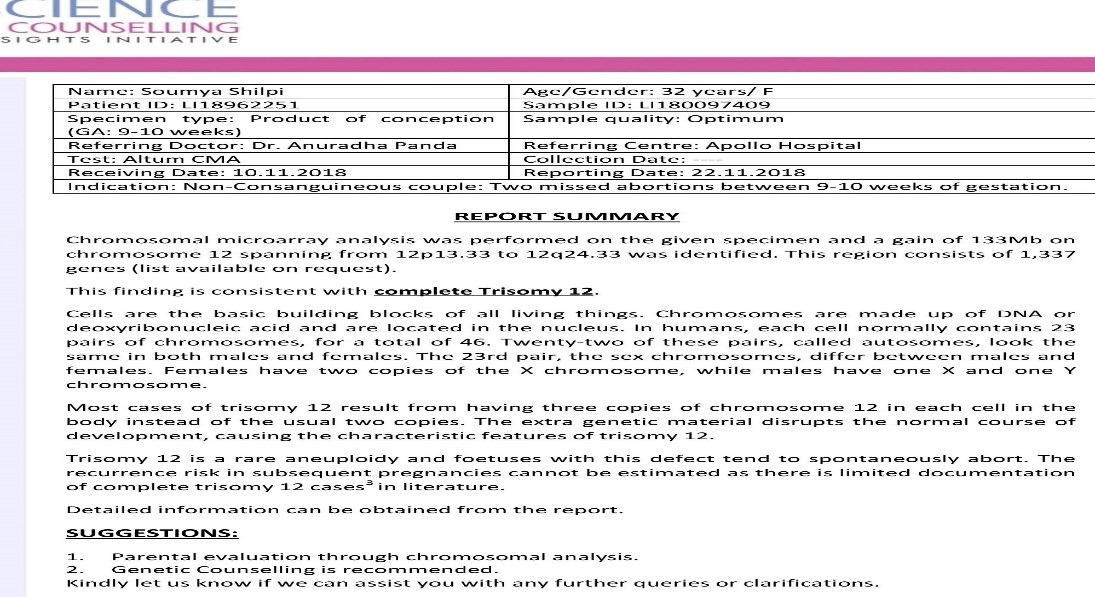
Fig.1- Report of chromosomal analysis of product of conception (GA 9-10wks) before treatment of case 1
Table 1 Symptoms considered for constitutional prescription for case 1
| Serial no | Symptoms |
| 1 | Company desire, due to fear to be alone |
| 2 | Memory weakness |
| 3 | Chilly patient and catches cold easily |
| 4 | Desires for sweets |
| 5 | Stool constipation and ineffectual |
| 6 | Tendency to abortion |
| 7 | Dysmenorrhoea with profuse flow of clotted blood |
| 8 | Palpitation chest |
| 9 | Breast painful before menses |
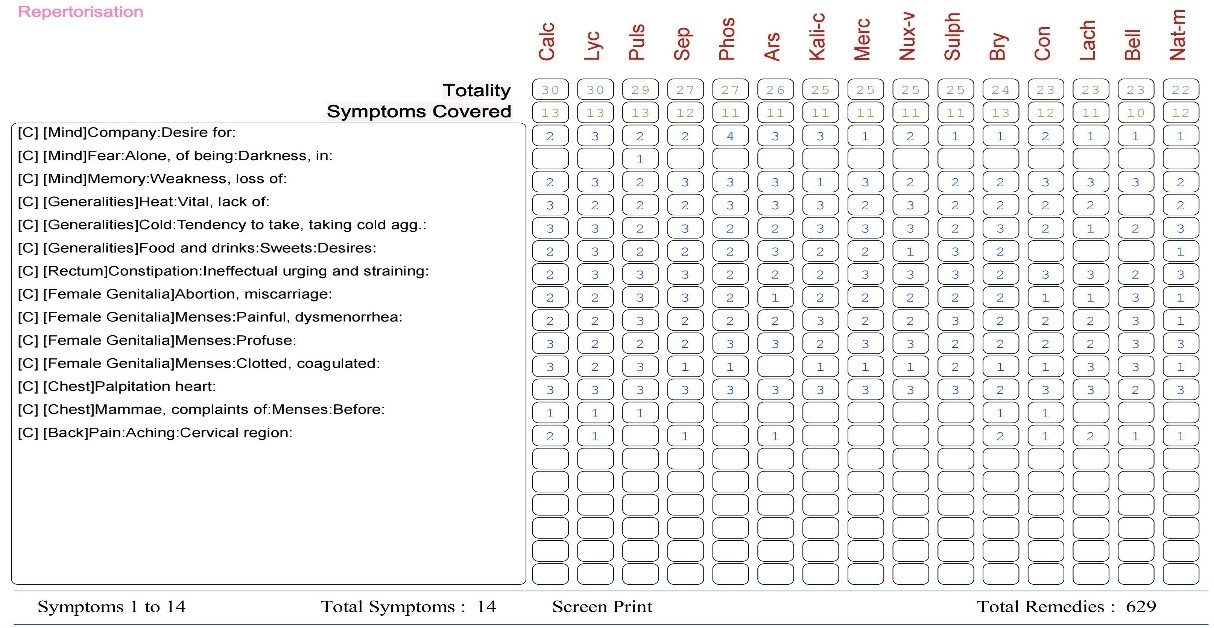
Fig. 2—Repertorial results (case 1)
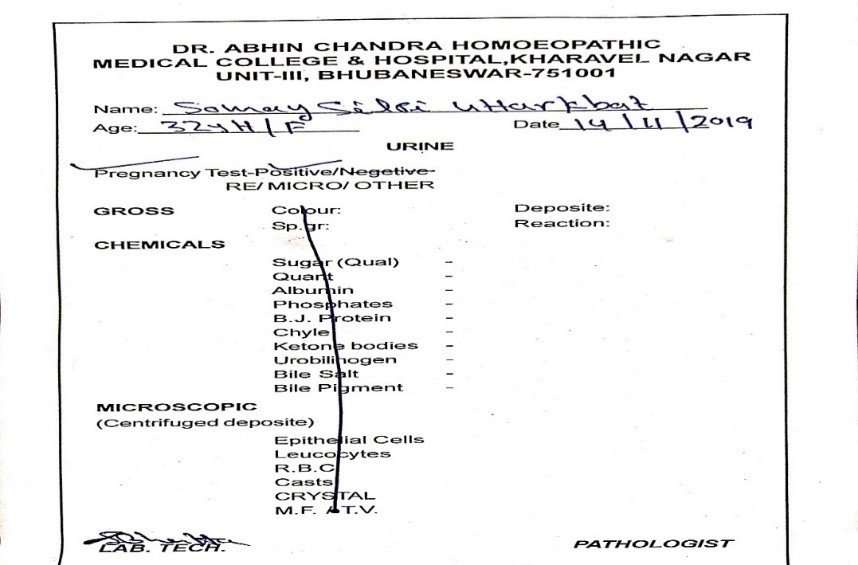
Fig. 3- Pregnancy test report after treatment (Case1)

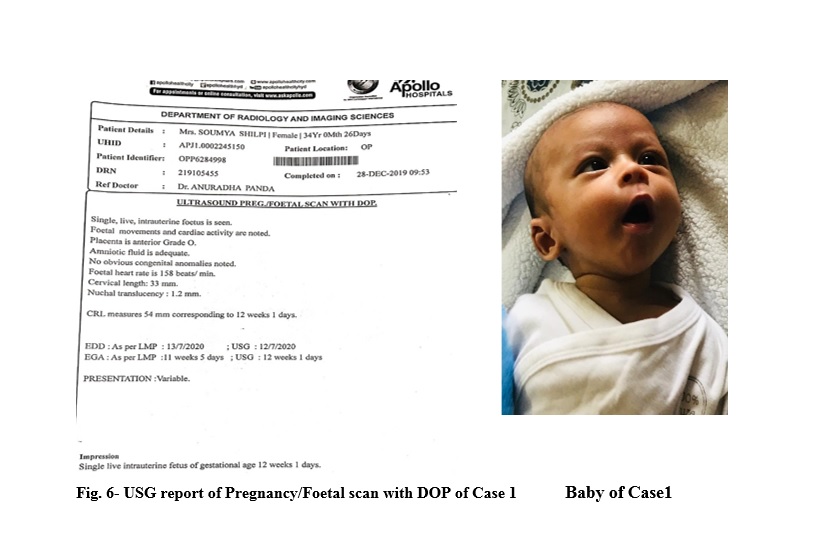
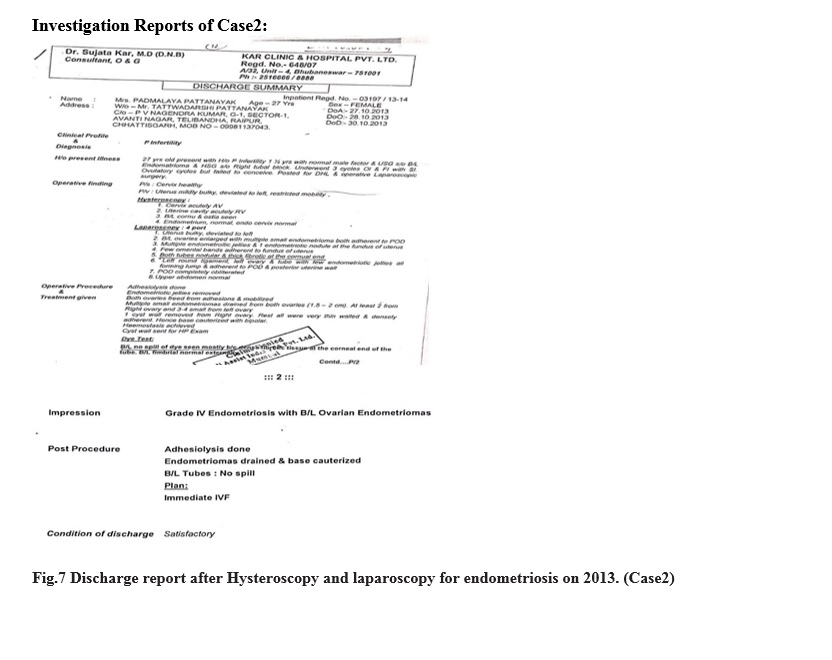
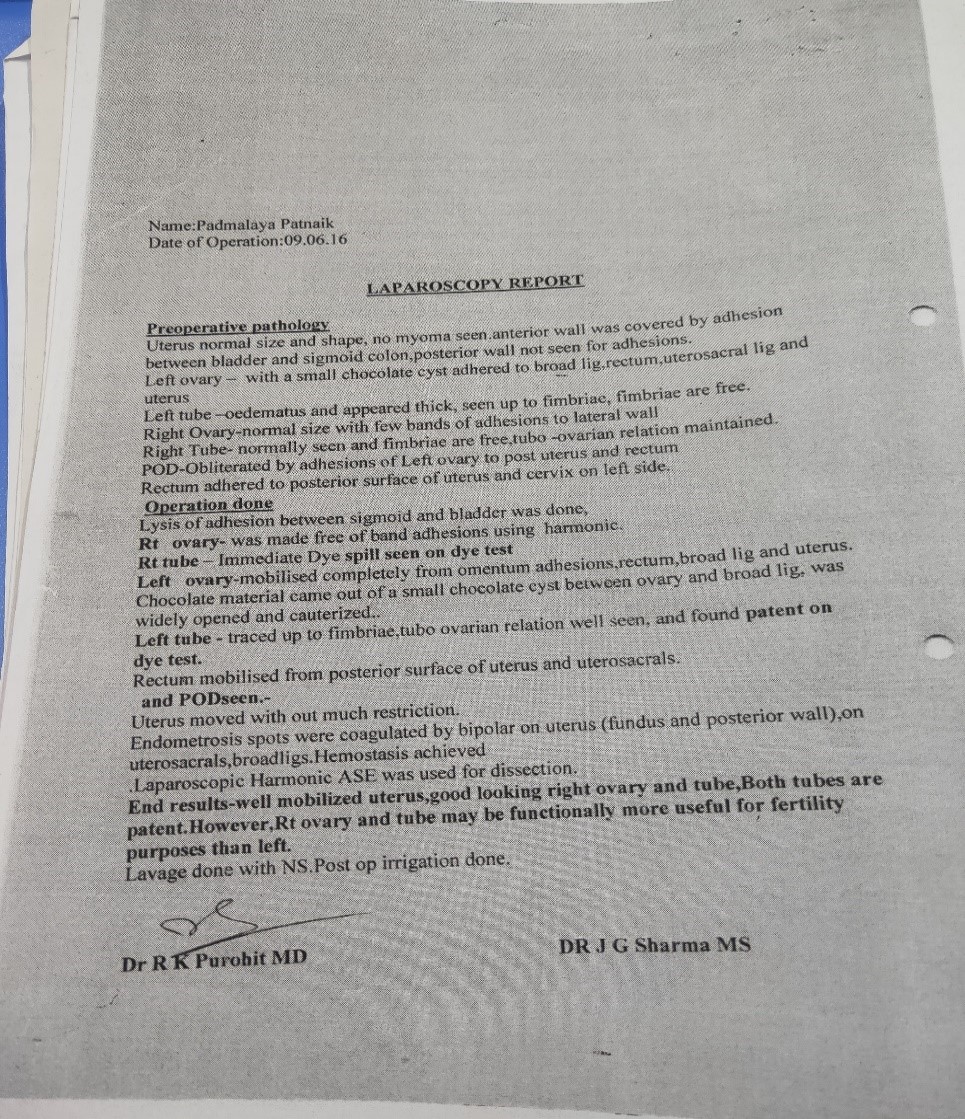
Fig 8.- Report of laparoscopy surgery for endometriosis on 2016(Case2)
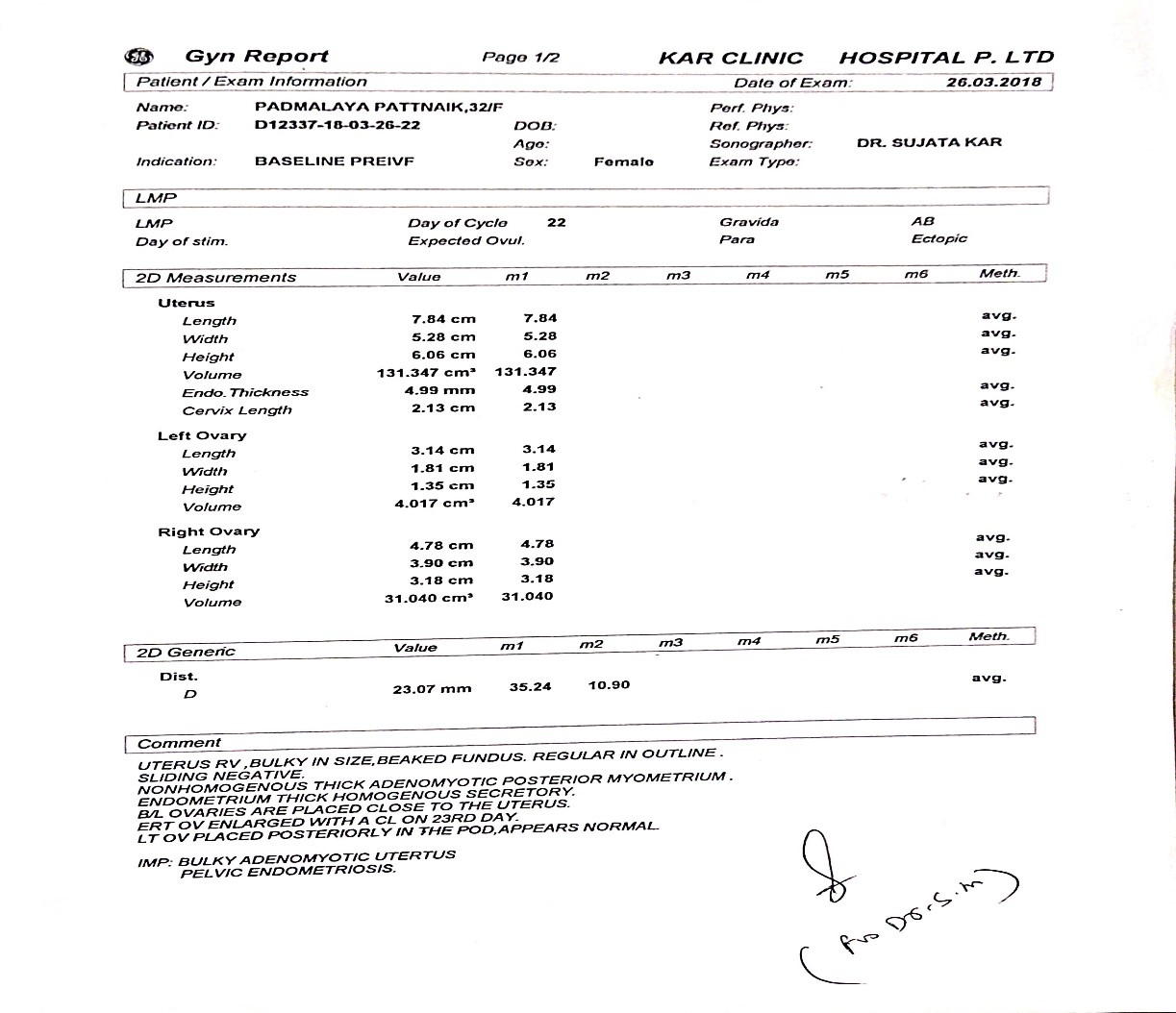
Fig. 9- USG Report of Pelvis on 2018 before treatment (Case 2)
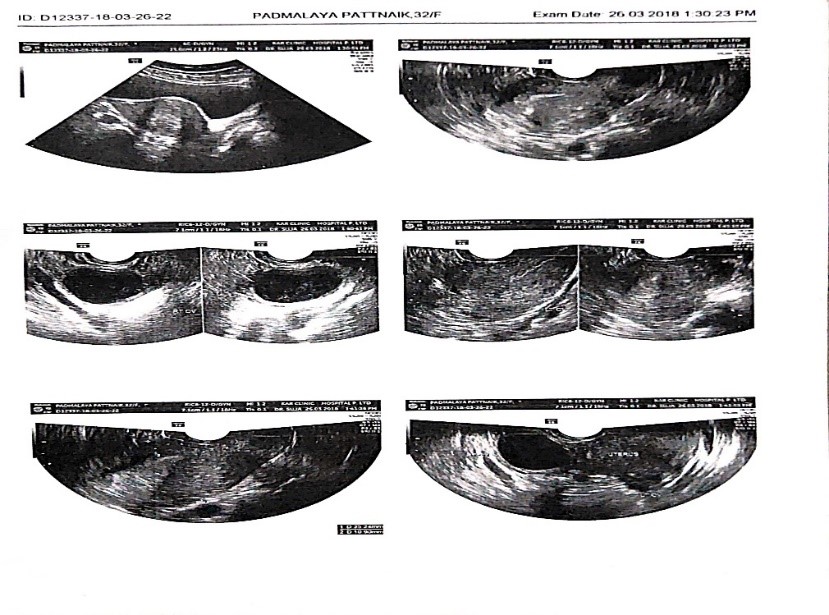
Fig. 10 USG photo before treatment (case 2).
Table 2 – Symptoms considered for constitutional prescription for case 2
| Sl No | Symptoms |
| 1. | Company desires |
| 2. | Weeping tendency and Emotional |
| 3. | Chilly patient |
| 4. | Desires for sour food |
| 5. | Easy satiety |
| 6. | Sweat more from whole body in summer |
| 7. | Dysmenorrhoea during periods, ameliorate as flow increases |
| 8. | Pain extends downwards, associated with flatulency |
| 9. | Endometriosis on USG of pelvis |
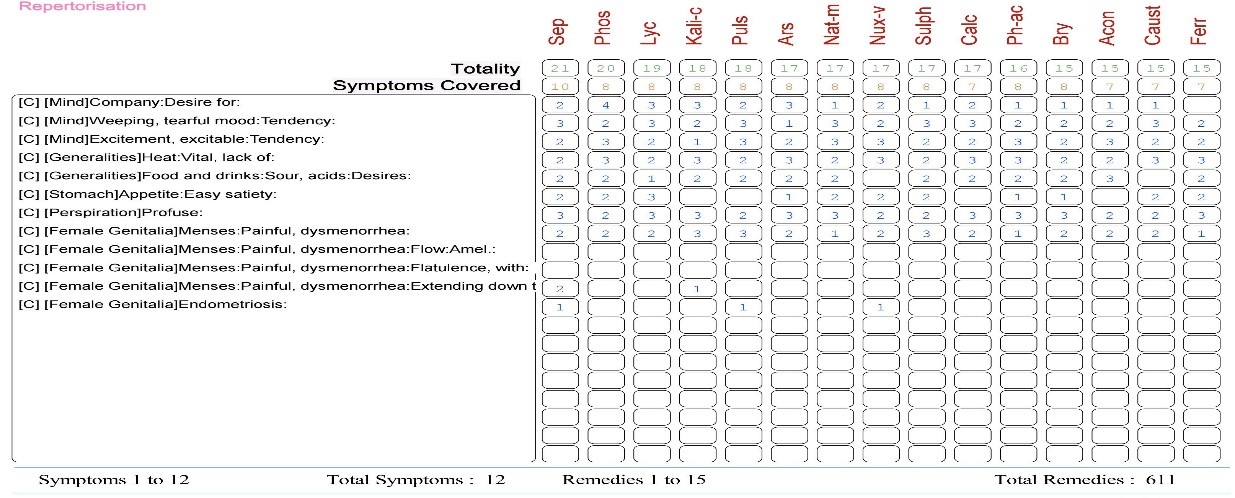
Fig.11 Repertorial results – Case2
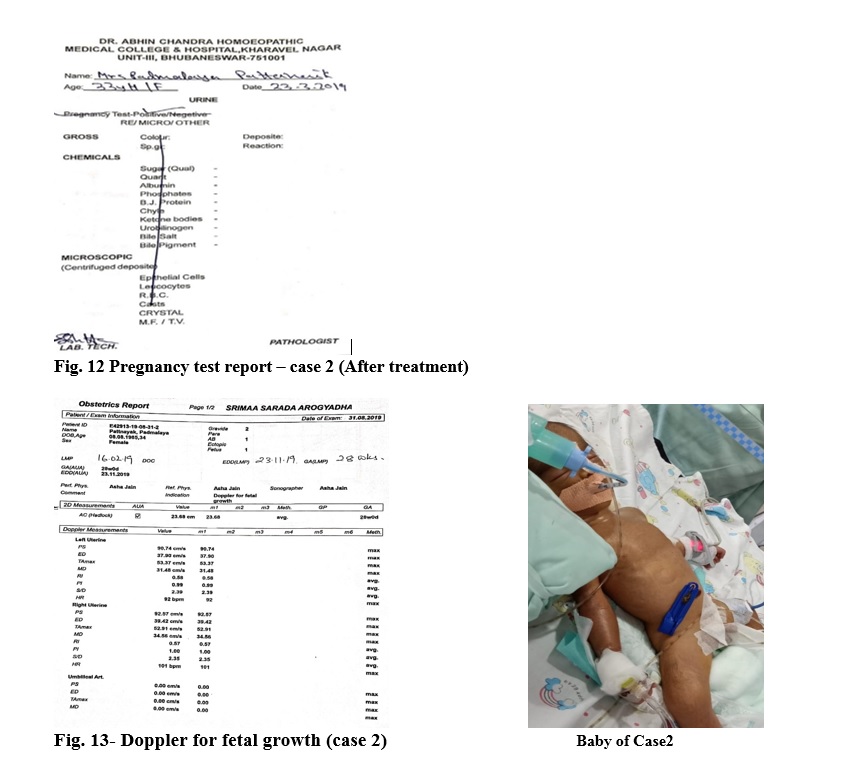
Fig. 12 Pregnancy test report – case 2 (After treatment)
Fig. 13- Doppler for fetal growth (case 2) Baby of Case2
There are several ways a homoeopathic remedy can be selected. But in these two cases, constitutional medicines were prescribed on the basis of mental symptoms, physical generals and particular symptoms of the patients which not only aided the removal of obstacles for conception swiftly but also helped in continuation of pregnancy, which is evident from the USG reports. So, the constitutional prescription can be the alternative option for homoeopaths for any pathology in body.
But selecting a constitutional remedy has its own limitations; extraction of general symptoms, particularly mental symptoms, in most of the cases is not so easy. Also, medicines with prominent mental and physical general symptoms are less in comparison with total available
medicines in our materia medica. Calcarea carbonicum and Sepia officinalis are well-known polychrest medicines of homoeopathic materia medica; their spheres of action cover almost all systems, including the female genital system. In these two cases, the prominent mental
and physical general symptoms with particulars of these two medicines facilitated first and subsequent prescriptions and ultimately yielded favorable results. It needs a prospective, multicentric observational study by the Central Council for Research in Homoeopathy (CCRH) for usefulness of homoeopathic medicines in treatment of Infertility.
Table 3 Summary of the cases: Case 1 and Case 2
| Case 1 | Case 2 | |
| Date of first visit | 01. 02.2019 | 11.12.2018 |
| Symptoms of first visit | Habitual abortion on second month of pregnancy. Severe pain during periods with profuse flow and clotted blood, associated with pain in breast and neck. Palpitation in chest when alone with fear. | Primary infertility of 7 years. Severe pain during periods extends to back and vagina with flatulency |
| Investigation report on first visit | Chromosomal study of product of conception – Complete trisomy 12 | Bulky adenomyotic uterus Pelvic endometriosis |
| Constitutional medicine prescribed with potency | Calcarea carbonicum 0/1-0/4, 30 ml each in 8doses, once daily. Jonosia ashoka Q/30ml 15drops bd, Viburnum opulus 30, 6 glob sos. | Sepia officinalis 0/1-0/4, 30ml each (8doses), once daily. Jonosia ashoka Q/15ml, 15 drops bd, Cimicifuga racemosa 30, 6globules sos. |
| Follow up | On 01.05.2019 During periods profuse flow and all types pain diminished. No palpitation. Calcarea carbonicum 0/5 and 0/6 30ml (8doses) had given in alternate morning. On 08.07.2019 Flow normal, No pain, fear and palpitation Calcarea carbonicum 0/7 and 0/8 was given in 30ml (8doses) each, twice a weak. On dt 14.11.2019 Nausea, weakness and head reeling in morning with delayed period of seven days. Pregnancy test report- positive Calcarea carb. 0/9,30ml (8doses) twice a week, Sabina 30, 6glob once daily morning. Investigation – 1st Trimester Risk assessment test for Trisomy 21, Trisomy 13 & Trisomy 18 all are indicating at low risk and below screening cut off(no chance of Downs Syndrome) She delivered a full term baby | 15.01.2019 Pain during period present, decreases after two days of appearance of menses as flow increases, associated with nausea. Sepia officinalis 0/5-0/6, 30ml each, in 8doses, was given alternate morning. 23.03.2019 First three days flow intermittently with pain which decreased on fourth day as flow increased. Flatulency in lower abdomen, nausea, weakness, and vertigo in morning. Pregnancy test positive Sepia officinalis 0/7, 30ml (8doses) twice a weak She delivered a premature baby due to placenta previa and revived after |
Acute remedies like Viburnum opulus and Cimicifuga are useful for painful menstruation basing on symptom peculiarity to reduce the pain acutely. But for permanent cure, constitutional medicine is required. Sabina 30 was prescribed for habitual abortion in first trimester.
Conclusion
If one keeps in view the limitation and complications of surgical procedures for endometriosis and IVF, well-selected homoeopathic medicines can provide a real solution with less money and painless procedure. More specifically, as evident from these two cases, menstruation with acute pain could resolve promptly with homoeopathic medicines. Well-selected homoeopathic constitutional remedies could produce favourable results, which may be a holistic, safe and effective solution to specific organopathic remedies, or even can be used as an add-on. But inferences drawn from these two case reports have limitations too, since the favourable outcomes of only two cases cannot be generalised for treatment of cases of endometriosis or chromosomal abnormality. Hence, randomized controlled study with larger sample size is suggested to establish the efficacy of homoeopathic constitutional remedies in the treatment of different causes of infertility.
Informed Consent
Written informed consent was obtained from both the patients.
Conflict of interest: The author declare that there is no conflict of interest.
REFERENCE
1. Kumar N And Singh A K, Trends of Male Factor in Infertility an important cause of infertility: A review of literature .Journal of Human Reproductive Sciences, 2015,vol8,4,191-6 doi 10.4103/0974-1208.170370. [Internate]Available from (https://www.ncbi.nlm.nih.gov/pmc/articles/PMC4691969/)
2. Brazier Y, Infertility in Men and Women, Medical News Today,2018,[Internate].Available from –
https://www.medicalnewstoday.com/articles/165748
3. Infertility, Myoclinic.org.,2021[Internet]. Available from https://www.mayoclinic.org/diseases-conditions/infertility/symptoms-causes/syc-20354317)
4. Decherney A H, Nathan L, Current Obstetric and Gynaecology Diagnosis and Treatment. International Edition(Ningth edition 2003):, Mc Graw Hill Medical Publishing Division, New Delhi.
5 .Infertility, Fact sheets, World Health Organization,2020.[Internate] Available from https://www.who.int/news-room/fact-sheets/detail/infertility
6. Padubidri VG, Daftary SN. Howkins and Bourne Shaw’s Text Book of Gynaecology.13th ed: India Pvt Ltd., New Delhi.
7. Infertility. Fertility and Reproductive Health Center | Obstetrics. [internate].Available from https://www.uclahealth.org/obgyn/infertility
8. Brazier Y, Infertility in Men and Women, Medical News Today,2018,[Internate].Available from –
https://www.medicalnewstoday.com/articles/165748
9. Dhawale ML. Principles and Practice of Homoeopathy. 3rd ed. Mumbai, India: Dr M L Dhawale Memorial Trust; 2004
10 Ullman D. Efficacy and Cost-Effectiveness of Homeopathic Medicine. ttps://homeopathic.com/efficacy-and-cost-effectiveness-of-homeo pathic-medicine/. Published 2018. Accessed December 12, 2018.
11 Boericke W. Pocket Manual of Homoeopathic Materia Medica with Repertory. 9th ed. New Delhi, India: B. Jain Publishers(p)Ltd; 1996
12 Mathur KN, Wadia SR. Principles of Prescribing. New Delhi, India: B. Jain Publishers(P)Ltd; 1998
13 Das B. Role of Constitution in Homeopathy.[Internate]2012[cited on dt 11 January2019].Available from:
https://www.homeobook.com/role-of-constitution-in-homeopathy/.
14 Sahoo AR, Mishra SC. Eliciting the mental symptoms and their corresponding rubrics. Decoding the Rubrics of Mind.2nd ed. New Delhi, India: Indian Books & Periodicals Publishers; 2016
15.Lobo A, D’cunha P, Lobo B. Effectiveness of Homoeopathic treatment in female infertility. Reproductive
Medicine international 1:008[Internate]2018[cited on dt Jan10 2022] Available from https://clinmedjournals.org/articles/rmi/reproductive-medicine-international-rmi-1-008.pdf
[doi: 10.23937/rmi-2017/1710008]16. Rajchandrasekhar B,Nair JKR, Sunny A,Manoharan A. Indivisualised Homoeopathic Medicine In Tne Treatment of Infertility.A case series.Homoeopathy,2021.doi:10.1055/s-0041-1725040.Epub ahead of print.PMID:34474497.[Internate] Available from https://pubmed.ncbi.nlm.nih.gov/34474497/–.
17. Masiello D J, Loike J D. Homoeopathic Treatment of Infertility. A Medical and Bioethical Prospective.[Internate] Available from https://medcraveonline.com/IJCAM/homeopathic-treatment-of-infertility-a-medical-and-bioethical-perspective.html. 06-Mar-2017.


